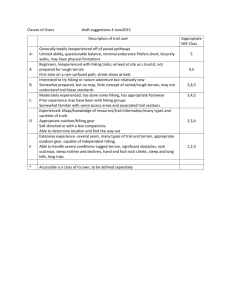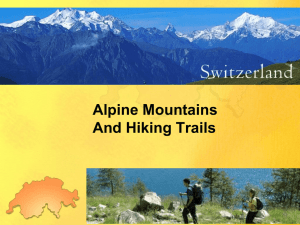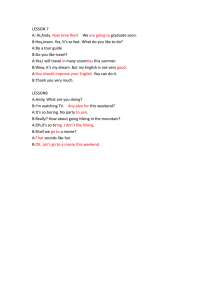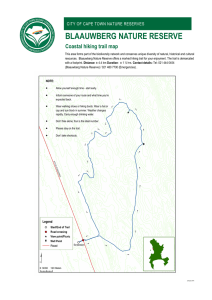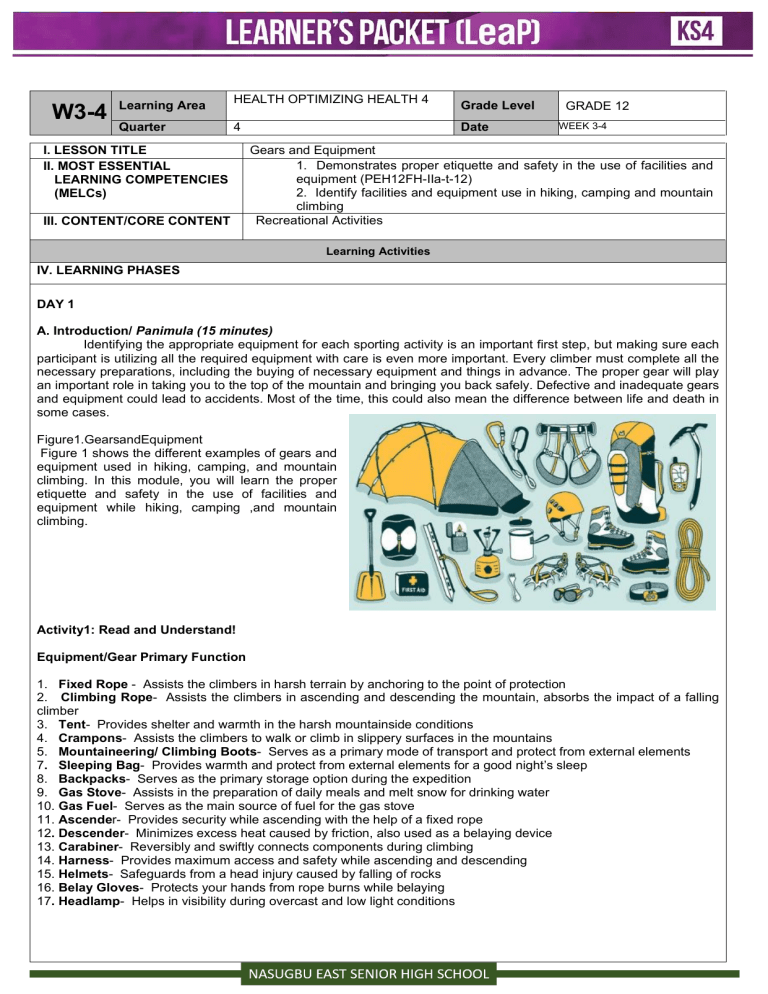
W3-4 Learning Area Quarter HEALTH OPTIMIZING HEALTH 4 Date 4 I. LESSON TITLE II. MOST ESSENTIAL LEARNING COMPETENCIES (MELCs) III. CONTENT/CORE CONTENT Grade Level GRADE 12 WEEK 3-4 Gears and Equipment 1. Demonstrates proper etiquette and safety in the use of facilities and equipment (PEH12FH-IIa-t-12) 2. Identify facilities and equipment use in hiking, camping and mountain climbing Recreational Activities Learning Activities IV. LEARNING PHASES DAY 1 A. Introduction/ Panimula (15 minutes) Identifying the appropriate equipment for each sporting activity is an important first step, but making sure each participant is utilizing all the required equipment with care is even more important. Every climber must complete all the necessary preparations, including the buying of necessary equipment and things in advance. The proper gear will play an important role in taking you to the top of the mountain and bringing you back safely. Defective and inadequate gears and equipment could lead to accidents. Most of the time, this could also mean the difference between life and death in some cases. Figure1.GearsandEquipment Figure 1 shows the different examples of gears and equipment used in hiking, camping, and mountain climbing. In this module, you will learn the proper etiquette and safety in the use of facilities and equipment while hiking, camping ,and mountain climbing. Activity1: Read and Understand! Equipment/Gear Primary Function 1. Fixed Rope - Assists the climbers in harsh terrain by anchoring to the point of protection 2. Climbing Rope- Assists the climbers in ascending and descending the mountain, absorbs the impact of a falling climber 3. Tent- Provides shelter and warmth in the harsh mountainside conditions 4. Crampons- Assists the climbers to walk or climb in slippery surfaces in the mountains 5. Mountaineering/ Climbing Boots- Serves as a primary mode of transport and protect from external elements 7. Sleeping Bag- Provides warmth and protect from external elements for a good night’s sleep 8. Backpacks- Serves as the primary storage option during the expedition 9. Gas Stove- Assists in the preparation of daily meals and melt snow for drinking water 10. Gas Fuel- Serves as the main source of fuel for the gas stove 11. Ascender- Provides security while ascending with the help of a fixed rope 12. Descender- Minimizes excess heat caused by friction, also used as a belaying device 13. Carabiner- Reversibly and swiftly connects components during climbing 14. Harness- Provides maximum access and safety while ascending and descending 15. Helmets- Safeguards from a head injury caused by falling of rocks 16. Belay Gloves- Protects your hands from rope burns while belaying 17. Headlamp- Helps in visibility during overcast and low light conditions Direction: Identify the name of the following equipment shown below. Choose your answer from the table, then describe the use of each equipment/gear in two to three sentences. Score__/10 Crampons Tent Head lamps Helmet Belay gloves Backpack Harnesses Carabiners Climbing rope Sleeping bag 1. _ _ e _ _ _ n _ _ a _ _______________ _______________ _______________ _______________ 2. B_ _ a _ _ _ _ _ e _ _______________ _______________ _______________ 6. 6. _ _ l _ _ _ __________________ __________________ __________________ 7. 7. _ _ n _ __________________ __________________ __________________ 3. 3. _ a _ _ _ a _ _ _______________ _______________ _______________ 8. 8. _ e _ _ _ _ _ _ s __________________ __________________ __________________ 4. 4. _ l _ mb _ _ _ r_ _ e _______________ _______________ _______________ 9. 9. _ a _ _ _ _ _ _ _ __________________ __________________ __________________ 5. 5. C _ _ _ _ _ _ s _______________ _______________ _______________ 10. 10. C _ r a _ _ n _ _ s __________________ __________________ __________________ 1. 2. 1. B. Development/ Pagpapaunlad (20 minutes) Ten Essential Systems 1. Navigation: map, compass, altimeter, GPS device, personal locator beacon (PLB) or satellite messenger 2. Headlamp: plus extra batteries 3. Sun protection: sunglasses, sunprotective clothes and sunscreen 4. First aid: including foot care and insect repellent (as needed) 5. Knife: plus a gear repair kit 6. Fire: matches, lighter, tinder and/or stove 7. Shelter: carried at all times 8. Extra food: Beyond the minimum expectation 9. Extra water: Beyond the minimum expectation 10. Extra clothes: Beyond the minimum expectation How to Stay Safe While Hiking 1. Hike at a fitness level that’s appropriate for everyone you’re with. Hiking trails are usually marked with a difficulty level ranging from easy to extreme. Make sure that the hiking trail you choose is appropriate for everyone in your group, especially if you’re bringing children or dogs along. 2. Learn to read a map and use a compass While you should always have a cell phone with you in case of emergency, be prepared to not have cell service on every hike. You should never rely on your phone’s GPS to guide you while on a hike. Instead, take some time to brush up on your map reading and compass skills before you head out. 3. Wear proper hiking gear Depending on the difficulty of your hike, you may be fine wearing sneakers or you may need to invest in a pair of hiking boots. Though a highquality pair of hiking boots can be expensive, they can also help prevent blisters (as can good hiking socks) and twisted ankles. 4. Protect your skin from the sun Before you begin your hike, it’s smart to put sunscreen on any exposed parts of your skin, including your face, ears, and neck. Even if it’s a cloudy day, you can still get a sunburn. 5. Stay hydrated while hiking Staying hydrated while hiking can make a world of difference in keeping you healthy. A good principle is to drink approximately 1 liter of water every 2 hours that you’re hiking. 6. Be aware of wildlife and take necessary safety precautions Before you head out on a hike, check online to find information about potential wildlife encounters in that area. 7. Get to know poisonous plants In the wild, there are many different types of plants—some are safe to touch, while others are incredibly poisonous. Before you go hiking, it’s a good idea to learn more about the types of plants you may find. 8. Make sure someone knows where you are at all times Lastly, when you go on a hike, let someone you trust know where you’re going, who you’re with, and when you expect to be back. Arrange to check in with them at a certain time. Hiking Etiquette: Do’s and Don’ts 1. Practice “Leave No Trace” Principle Always pick up after yourself. Don’t throw your garbage along the trails or in your campsite. Keep a trash bag in your backpack and store your trash there temporarily. Make sure that you’re not dropping plastic wrappers from your trail food, or leaving empty water bottles, used tissues, etc. Leave nothing but footprints, take nothing but photographs. 2. Stay on the Trail Don’t stray from the established trail nor try to take another path, as this necessarily damages the surrounding plants. Additionally, don’t cut down trees or damage any vegetation to set up camp. Only pitch tents at dedicated campsites. As hikers, always aim to make the least impact on the mountains you visit to keep them healthy and to maintain their beauty. 3. Keep Unnecessary Noise to a Minimum Don’t blast loud music while hiking. This does not disturb only local wildlife, but it also disrespects other mountaineers who prefer to hike in silence or listen to the sounds of nature. Use your earphones if listening to music helps you hike. 4. Be Compassionate and Helpful to Fellow Hikers If you see any hiker encountering some kind of difficulty along the trail assist them as much as you can. If a fellow hiker ran out of trail food and you have more to spare, offer it to him/her. What comes around goes around. 5. Observe ‘Right of Way’ on the Trails Always give way to locals who are going about their daily lives. If you are descending, give way to hikers who are going uphill. Additionally, if your pace is slow, make way for fast-moving hikers. Similarly, if you are fast, politely ask slowmoving hikers for permission to advance on the trail. 6. Be Nice to Your Local Guides and Treat them with Respect Introduce yourself to the guide and make your guide feel like a part of your group. Invite them during socials, and offer them food and water. If your guide is moving too fast and way ahead of the team, politely ask him/her to slow down. Additionally, if you ask the guide to act as a porter, make sure to give extra compensation. Score__/10 ACTIVITY: Doing Things Right. ( 2 points each) Direction. Explain the followingsafety precautions while hiking or camping in your own understanding. 1. Hike at a fitness level that’s appropriate for everyone you’re with. __________________________________________________________________________________ __________________________________________________________________________________ 2. Stay hydrated while hiking. __________________________________________________________________________________ __________________________________________________________________________________ 3. Make sure someone knows where you are at all times. __________________________________________________________________________________ __________________________________________________________________________________ 4. Make camp before dark. __________________________________________________________________________________ __________________________________________________________________________________ 5. Protect yourself from carbon monoxide poisoning. __________________________________________________________________________________ __________________________________________________________________________________ DAY 2 C. Engagement/ Pakikipagpalihan (50 minutes) ACTIVITY: TAKING A HIKE Direction: Make a poster explaining the given hiking etiquette below. Score__/20 RUBRIC Competence Required Elements /10 Graphics Relevance /5 Attractiveness /5 Total: /20 D. Assimilation/ Paglalapat (30 minutes) Score__/10 ACTIVITY: Do’s and Don’ts Direction. Explain each of the following etiquette in hiking in your own understanding. (2 POINTS EACH) 1. Stay on the trail. ________________________________________________________________________________________ ________________________________________________________________________________________ 2. Keep unnecessary noise to a minimum. ________________________________________________________________________________________ ________________________________________________________________________________________ 3. Be compassionate and helpful to fellow hikers. ________________________________________________________________________________________ ________________________________________________________________________________________ 4. Observe ‘Right of Way’ on the trails. ________________________________________________________________________________________ ________________________________________________________________________________________ 5. Be nice to your local guides and treat them with respect. ________________________________________________________________________________________ ________________________________________________________________________________________ V. ASSESSMENT (5 minutes) Directions: Read carefully each item. Use a separate sheet for your answers. Write only the letter of the best answer for each test item. Score__/5 1. What footwear is more advisable to use for longer treks with heavy loads? A. Backpacking boots B. Heavy Hiking boots C. D. Lighter Hikingboots Hiking sandals 2. What would be the best footwear to use for well-defined trails, shorter hikes and relatively lighter loads? A. Backpacking boots B. Heavy Hiking boots C. Lighter Hikingboots D. Hiking sandals 3. Which of the following statements is NOT an example of proper etiquette when performing a physical A. B. C. D. activity? Obeying the judges Questioning a decision made by the judges Shouting “well done” to one of the dancers Shaking hands with your opponent at the end of a match 4. In planning the food for trekking or hiking, what important things are to be considered? I. Duration of the activity II. Calorie requirement for the activity III. Manageability to load, carry, store and cook A. I only B. II only C. III only D. I, II and III 5. What should be done in order to prevent accidents when you do mountain climbing or hiking activities? I. have self-discipline II. perform warm-up exercise III. help maintain facilities and proper use of equipment A. I only B. II only C. I and II D. I, II and III VI. REFLECTION (10 minutes) Direction: Write your personal thoughts about the lesson using the prompts below. I understand that____________________________________________________________ I realized that______________________________________________________________ VII. REFERENCES • • • https: //www.superteacherworksheets.com/generator-word- search.html https://guidetothephilippines.ph/articles/ultimate- guides / hiking-philippines-guide https: //www.solvhealth.com/blog/ 10-ways-to-stay-safe-while-hiking- and-camping-2018-guide Prepared by: Sherwin Mark V. Sisante Nasugbu East Senior High School 09173042964 Mark Sherwin VS sherwin.sisante@deped.gov.ph Checked by: Development Team Sherwin Mark V. Sisante/ Subject Coordinator Fritz Gerald B. Buenviaje/ LR Coordinator Janice R. Geli/School Principal
